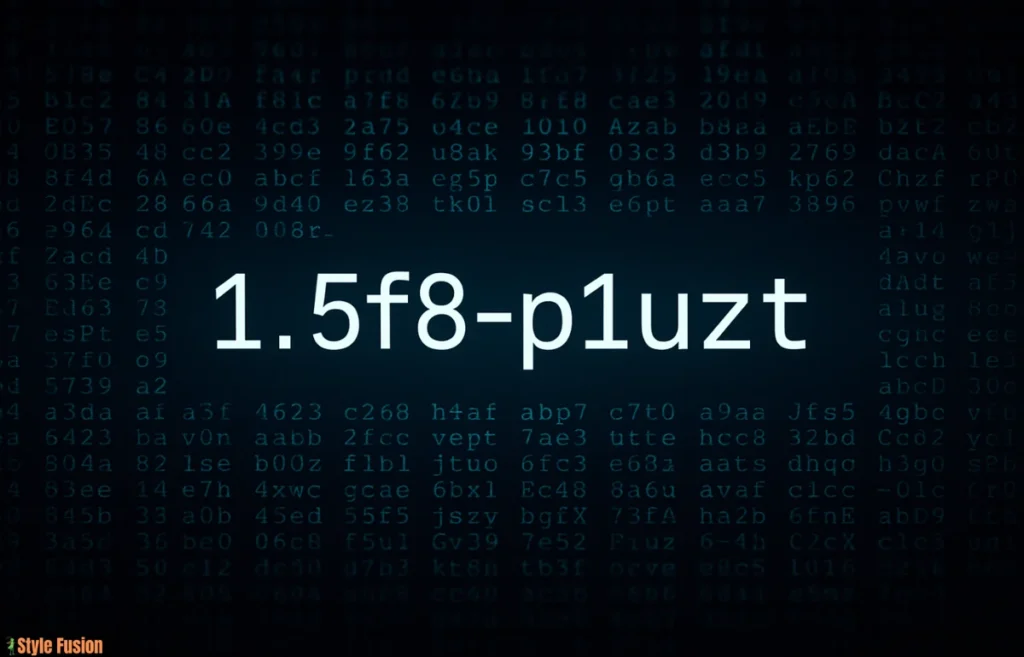
In today’s data-driven world, we’re constantly interacting with digital systems that depend on identifiers—some easily understood, others puzzling. One such mystery is the string “1.5f8-p1uzt”. At first glance, it looks random, maybe even meaningless. But in computing and software environments, alphanumeric codes like this often serve a critical purpose.
This article explores what 1.5f8-p1uzt could represent, its potential uses, and how you can interpret such identifiers in different technical scenarios. While there’s no universal definition for this exact string, understanding its structure can help uncover its meaning in your specific context.
Understanding Alphanumeric Strings Like 1.5f8-p1uzt
Across digital platforms, alphanumeric codes serve vital roles such as monitoring activity, identifying assets, safeguarding systems, and tagging updates. The format of 1.5f8-p1uzt offers some clues: it combines numbers, periods, and lowercase letters in a way that suggests it could be a version number, a hashed identifier, or a system-generated token.
Let’s break it down:
Breaking Down the Format
-
“1.5f8” might be a version or a semantic indicator
-
“p1uzt” could be a hash, a token, or part of a session ID
-
The combination of numbers and letters points toward automated or dynamic generation
Common Uses for Identifiers Like 1.5f8-p1uzt
While the true meaning of this string depends on where it appears, let’s look at where similar identifiers are commonly used.
1. Unique Identifiers (UIDs)
In databases or cloud-based systems, UIDs are used to uniquely tag a record or object. This prevents duplication and ensures accurate referencing.
2. Version Control Tags
The “1.5” portion of 1.5f8-p1uzt hints at software versioning. Some dev teams use hybrid semantic identifiers to track versions and commits, especially in environments like Git.
3. Hash Values or Keys
Hash values are used for security, indexing, and verification. Although 1.5f8-p1uzt is not a typical SHA-256 or MD5 hash, it may be a truncated or customized version.
4. Session or Transaction IDs
Online platforms often use dynamic IDs to track user sessions, authentication tokens, or real-time transactions. If you see this in a web request or a URL parameter, it could be part of a session trail.
5. File or Asset References
Automated systems—especially in gaming or media processing—generate coded filenames. This string might refer to a temporary asset, user config, or server snapshot.
Use Cases by Industry
Here’s a closer look at how 1.5f8-p1uzt or similar strings may be used in various sectors:
| Industry | Possible Use for 1.5f8-p1uzt | Purpose |
|---|---|---|
| Software Development | Build/version ID | Track deployment or code version |
| Cloud Computing | VM or container instance ID | Identify a unique resource in the cloud |
| Database Management | Primary or foreign key | Link related records across tables |
| Networking | Packet/session ID | Manage data flow and sessions across nodes |
| Gaming | Asset reference or session code | Link user, level, or object state |
| Cybersecurity | Token or encoded string | Used for authentication, permissions, or access control |
How to Interpret Strings Like 1.5f8-p1uzt
Understanding identifiers like this comes down to context. Without knowing where you found the string, decoding it is mostly speculative. However, there are several strategies to help you narrow down its purpose.
Check the Source
Did you see 1.5f8-p1uzt in a log file, database, or web app? That information is crucial. A build log, for instance, would likely mean it’s a commit or error identifier.
Examine Related Information
Look around the identifier. Are there timestamps, error codes, IP addresses, or system labels? These can offer valuable clues.
Search Documentation
Most structured systems—especially APIs and databases—come with developer documentation. Check for a section on IDs, tokens, or naming conventions.
Use Dev Tools
In browser dev tools or backend monitoring systems, you might track how and where the identifier is passed or generated. This can hint at its role.
Consult the Community
If the identifier belongs to open-source software or a known framework, forums like Stack Overflow or GitHub may already have users discussing its meaning.
Security and Privacy Considerations
While these strings may seem meaningless to the average user, some identifiers can contain or reveal sensitive data. Never share such strings publicly unless you’re sure they don’t compromise access or privacy.
Some tokens are linked to:
-
Authentication credentials
-
Encrypted messages
-
Confidential file locations
Be cautious—when in doubt, treat all obscure system-generated strings as potentially sensitive.
Why Context Is Everything
It’s worth repeating: there’s no universal decoder ring for something like 1.5f8-p1uzt. Without understanding the environment—be it a specific application, database system, or cloud infrastructure—you can only form educated guesses.
Still, recognizing the common patterns and usage areas can help you ask the right questions, search the right places, and ultimately figure out what the string does and why it matters.
FAQs About 1.5f8-p1uzt
[rank_math_rich_snippet id=”s-f28b34a7-8153-43cb-9b1b-6789f967b55f”]
Final Thoughts: Decoding the Mystery
While 1.5f8-p1uzt may not have a one-size-fits-all explanation, understanding how these identifiers are used across systems gives you the tools to interpret their purpose. Whether you’re a developer, analyst, or curious user, always start with context.
If you encounter similar strings in your work, take the time to explore their origin. It may lead to insights into your system’s architecture, performance, or even hidden bugs.
Want to dig deeper into identifiers and backend systems? Subscribe to our technical breakdowns and guides for developers, analysts, and cybersecurity professionals.

Dear Readers, I’m Salman Khayam, the writer and founder of this blog, dedicated to bringing you valuable insights across a variety of topics. From dental and mental health to personal development, beauty, skincare, hair care, nutrition, fitness, and exercise, my goal is to empower and inspire through well-researched, engaging content.
